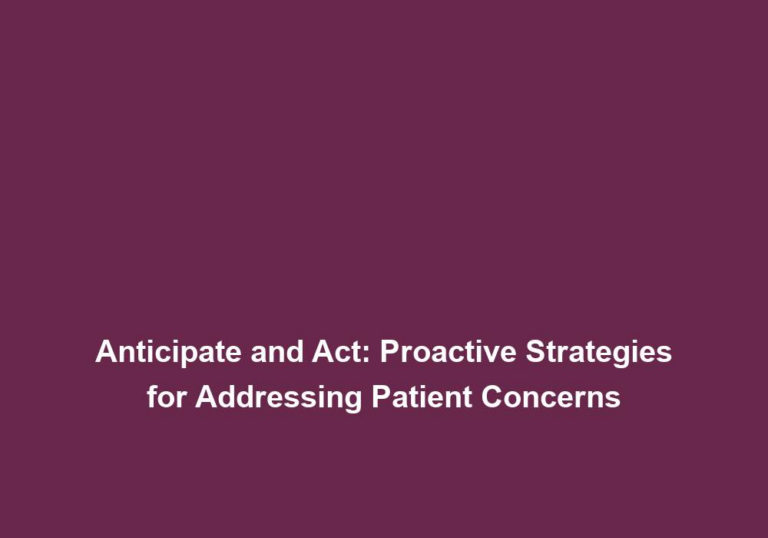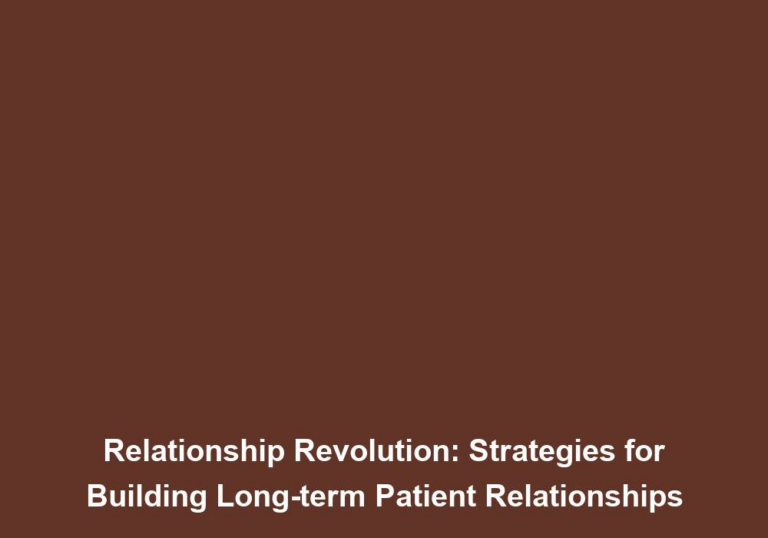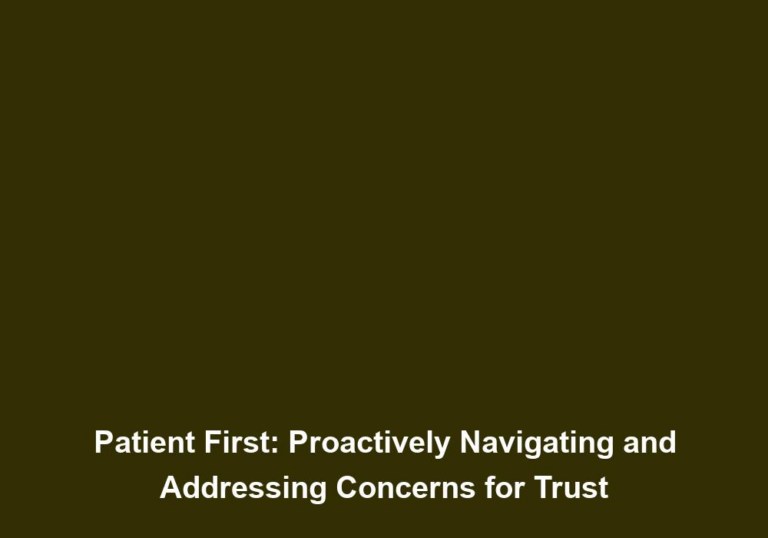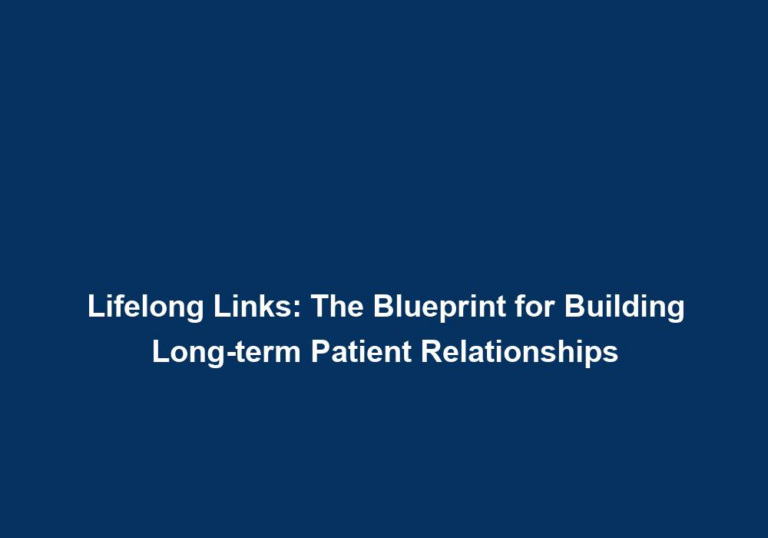Lifelong Links: The Blueprint for Building Long-term Patient Relationships
In the fast-paced world of healthcare, building strong and long-term relationships with patients is essential. As a healthcare provider, your patients’ trust and loyalty are crucial not only for their well-being but also for the success and growth of your practice. In this article, we will explore the blueprint for building lifelong links with your patients, ensuring their satisfaction and fostering a lasting connection.
Understanding the Importance of Long-term Patient Relationships
Before diving into the strategies for building long-term patient relationships, it is crucial to understand why they are so vital. Long-term patient relationships have numerous benefits, including:
-
Enhanced Patient Satisfaction: When patients have a strong bond with their healthcare provider, they feel heard, understood, and valued. This significantly improves their overall satisfaction with the care they receive.
-
Continuity of Care: Long-term patient relationships facilitate continuity of care, ensuring that patients receive consistent, personalized treatment. This is especially important for individuals with chronic conditions or complex medical histories.
-
Increased Patient Loyalty: Building a lasting connection with your patients promotes loyalty. Loyal patients are more likely to continue seeking your services, refer others to your practice, and remain engaged in their healthcare journey.
-
Improved Health Outcomes: When patients trust their healthcare provider and feel comfortable discussing their concerns openly, it can lead to improved health outcomes. Effective communication and a strong patient-provider relationship positively impact treatment adherence and patient engagement.
The Blueprint for Building Long-term Patient Relationships
- Effective Communication: Communication is the cornerstone of any successful patient-provider relationship. It is important to create an environment where patients feel comfortable expressing their concerns and asking questions. Actively listening to their needs, providing clear explanations, and involving patients in their healthcare decisions are essential.
- Actively listen and show empathy: Take the time to listen to your patients, validate their concerns, and show genuine empathy. This helps build trust and makes them feel valued.
- Offer clear explanations: Ensure that you use simple and understandable language when explaining medical conditions, treatments, and procedures. Patients appreciate clear communication that empowers them to make informed decisions.
- Involve patients in their healthcare decisions: Encourage patients to actively participate in their own healthcare by involving them in the decision-making process. This can be done by discussing treatment options, risks, and benefits, and respecting their preferences and values.
- Personalization: Tailoring your interactions and care plans to each patient’s unique needs and preferences is key to building strong and long-term relationships. Personalization enhances the patient-provider relationship by showing that you genuinely care about their individual circumstances.
- Remember personal details: Make an effort to remember personal details about your patients, such as their hobbies, family, and interests. This personal touch helps create a connection beyond the medical setting.
- Address patients by name: Using a patient’s name during interactions helps create a sense of familiarity and personalization.
- Offer customized treatment options: Consider each patient’s specific needs, preferences, and goals when developing treatment plans. This shows that you take into account their individual circumstances, leading to a more satisfying healthcare experience.
- Empathy and Compassion: Demonstrating empathy and compassion towards your patients is essential for building trust and fostering long-term relationships.
- Show genuine concern: Take the time to understand your patients’ emotions and challenges. Be supportive, compassionate, and considerate of their feelings, which helps create a safe and trusting environment.
- Understand cultural differences: Be aware of cultural differences and how they may affect patients’ perceptions and healthcare experiences. Respect and adapt to their cultural backgrounds to provide culturally competent care.
- Tailor communication to emotional needs: Some patients may require more emotional support than others. Adjust your communication style accordingly, providing reassurance, empathy, and understanding when needed.
- Patient Education: Educating your patients about their conditions, treatments, and preventive measures is crucial for empowering them to actively participate in their own healthcare.
- Provide clear and accessible information: Offer educational materials, such as brochures, pamphlets, or online resources, that explain medical conditions, treatment options, and preventive measures in a clear and easily understandable manner.
- Encourage questions and provide answers: Create an environment where patients feel comfortable asking questions and seeking clarification. Respond to their queries with patience and provide comprehensive answers to ensure they have a thorough understanding of their healthcare journey.
- Foster health literacy: Help patients develop the knowledge and skills necessary to make informed decisions about their health. This includes promoting an understanding of medical terminology, interpreting test results, and recognizing signs and symptoms that require attention.
- Proactive Care: Going beyond reactive treatment and reaching out to patients regularly, even when they are not actively seeking treatment, is a powerful way to build long-term relationships.
- Conduct preventive screenings: Schedule regular check-ups and screenings to detect potential health issues early. Proactively reaching out to patients for these screenings shows your commitment to their well-being and prevention.
- Send reminders for check-ups: Utilize technology to send automated reminders for routine check-ups, vaccinations, and screenings. This helps patients stay on track with their healthcare and demonstrates your dedication to their long-term health.
- Offer relevant health information: Provide patients with educational resources, such as newsletters, blog articles, or social media posts, that offer valuable health information and tips for maintaining a healthy lifestyle.
- Utilize Technology: Leveraging technology can greatly enhance patient experiences and streamline communication, making healthcare more convenient and accessible.
- Implement patient portals: Patient portals allow patients to access their medical records, schedule appointments, request prescription refills, and communicate securely with their healthcare providers. This promotes patient engagement and empowers them to take an active role in managing their health.
- Utilize telemedicine solutions: Telemedicine enables remote consultations, providing patients with convenient access to healthcare professionals. This is especially beneficial for patients with limited mobility or those living in remote areas.
- Offer online appointment scheduling: Implement an online appointment scheduling system that allows patients to book appointments at their convenience. This eliminates the need for phone calls and reduces wait times, improving the overall patient experience.
- Facilitate secure messaging: Implement a secure messaging system that allows patients to communicate directly with their healthcare providers. This enhances communication outside of in-person visits and supports timely and efficient responses to patient inquiries.
- Provide valuable educational resources: Utilize technology to share educational resources, such as videos, infographics, or interactive tools, that empower patients with knowledge and encourage active participation in their healthcare.
- Feedback and Continuous Improvement: Regularly collecting feedback from your patients is essential for gauging their satisfaction and identifying areas for improvement. Actively addressing their concerns and suggestions demonstrates your commitment to quality care and strengthens the patient-provider relationship.
- Conduct patient satisfaction surveys: Implement surveys to gather feedback on patients’ experiences with your practice. Ask specific questions about communication, wait times, staff interactions, and overall satisfaction to identify areas for improvement.
- Act on feedback: Take the feedback received seriously and make necessary improvements based on the suggestions and concerns raised by your patients. This shows that their opinions are valued and that you are dedicated to providing the best possible care.
- Communicate changes and improvements: Share updates with your patients regarding the changes made in response to their feedback. This demonstrates transparency and shows that their input has influenced positive changes in the practice.
- Community Engagement: Engaging with your local community through educational workshops, health fairs, and other initiatives helps establish your practice as a trusted healthcare resource. This attracts new patients while reinforcing your commitment to existing ones.
- Offer educational workshops: Organize workshops on various health topics to educate the community and promote preventive care. This positions your practice as a valuable source of information and expertise.
- Participate in health fairs: Set up booths at local health fairs to provide information, screenings, and consultations to community members. This allows you to directly interact with potential patients and demonstrate your commitment to their well-being.
- Collaborate with community organizations: Partner with local community organizations, such as schools or non-profit groups, to support health-related initiatives. This involvement showcases your practice’s dedication to the community and builds trust.
- Staff Training: Ensuring that all members of your healthcare team are trained in patient-centered care is crucial for maintaining consistent and exceptional experiences. From the front desk staff to the medical professionals, a cohesive approach to patient care is essential.
- Provide training on communication skills: Offer training programs that focus on effective communication, active listening, and empathy. This equips your staff with the skills needed to create a positive patient experience.
- Foster a patient-centered culture: Instill a patient-centered mindset in your staff by emphasizing the importance of building long-term relationships and providing exceptional care. Encourage staff members to go above and beyond in meeting patients’ needs.
- Continuously educate and update staff: Healthcare is a constantly evolving field, so it is vital to provide ongoing education and training to keep your staff up to date with the latest medical advancements and best practices in patient care.
Conclusion
Building lifelong links with your patients is the foundation for a successful and thriving healthcare practice. By prioritizing effective communication, personalization, empathy, patient education, and proactive care, you can establish a strong patient-provider relationship that fosters trust, loyalty, and improved health outcomes. Implementing technology, seeking feedback, engaging with the community, and investing in staff training further solidify your commitment to building long-term patient relationships. Embrace this blueprint and watch as your practice flourishes with satisfied patients who choose you as their trusted healthcare partner.







